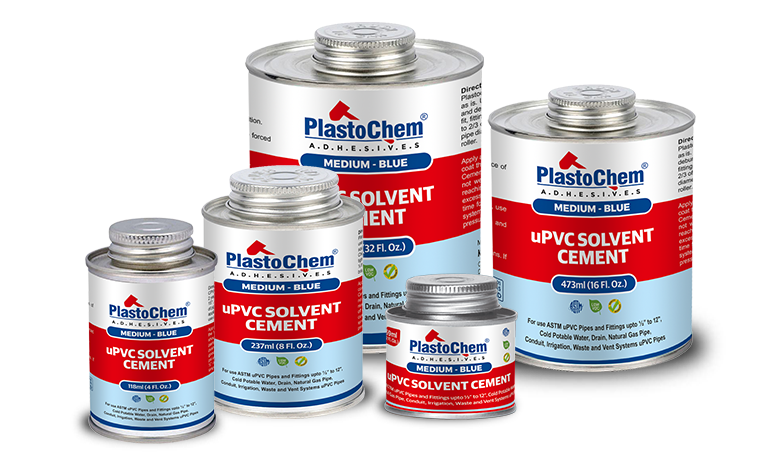Tips for Choosing the Right Solvent Cement
Identify Your Material
For any plumbing system, you have to know the project is design with which types of piping system, coz the pipe is selected according to the requirement of the project, and solvent cement must be select according the project piping system. There are many types pipes available in the market i.e. PVC pipes, UPVC pipes, CPVC pipes, ABS pipes.
- PVC (Polyvinyl Chloride): Use a solvent cement designed specifically for PVC. It’s usually labeled as “PVC cement.”
- CPVC (Chlorinated Polyvinyl Chloride): For CPVC pipes, use a cement designed for this material, typically marked “CPVC cement,” as it handles higher temperatures.
- uPVC (Unplasticized Polyvinyl Chloride) piping system is widely used in plumbing, drainage, and industrial applications due to its excellent durability, corrosion resistance, and cost-effectiveness. uPVC pipes are rigid and do not contain plasticizers, making them a suitable choice for systems requiring structural strength.
- ABS (Acrylonitrile Butadiene Styrene): ABS is used in many drain, waste, and vent systems; it is recognized to be strong and impact-resistant. Often used in drain, waste, and vent systems.
- Other materials: If you’re working with other materials like PVC/ABS combinations or rubberized pipe joints, ensure the cement is compatible with both materials.
Identify the Pipe Size of the project - Regular: For smaller pipes (usually up to 4 inches), a regular solvent cement will do.
- Large Pipes: For pipes larger than 4 inches in diameter, you may need a thicker cement formula or a heavy-duty option.
Know the temperature range (hot or cold) - Standard Temperature: Most solvent cements are made for standard temperature ranges (usually 40°F to 120°F). If your pipes will be exposed to extreme heat or cold, choose a cement formulated to handle those conditions.
- High Temperature: For hot water systems, select cement rated for high temperatures, such as Plastochem CPVC solvent cement is designed for use in hot water lines.
Know the setting time - Fast-setting: If you need to make quick repairs, look for a fast-setting cement that cures in minutes.
- Regular-setting: For larger, more complex projects, a slower-setting cement may give you more time to adjust and position the pipes correctly before the cement cures.
Application Conditions - Indoor Use: Most solvent cements are designed for indoor use. However, if you are working outdoors, select a cement that is specifically rated for outdoor use to prevent degradation from UV exposure.
- Wet Conditions: Some solvent cements can work in wet or damp conditions, but always check the manufacturer’s guidelines to ensure suitability for your specific project.
Know the types of project - Pressure Systems: If the pipes are part of a pressurized system (e.g., water supply), use a solvent cement that is rated for pressure applications.
- Non-Pressure Systems: For drains, waste, and vent pipes (which aren’t pressurized), you can use a less specialized cement.
Check the Standards and Certification of the Solvent Cements - Check the project is as industry standards such as ASTM (American Society for Testing and Materials), ISI, ISO standards etc., especially when working in professional or regulated environments. This ensures the cement is strong and safe for use.
By considering these above factors, you can choose the right solvent cement to make your pipe joint secure, leak-free, and long-lasting.




